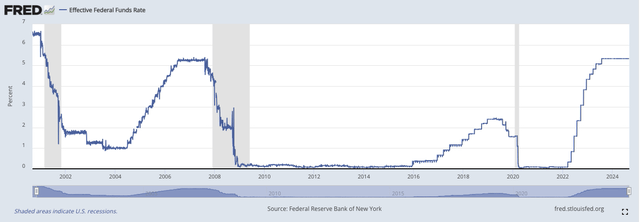I last covered Enphase Energy (NASDAQ:ENPH) in June; since then, the stock has lost 8.78% in price, but I believe we are now at an inflection point, with upside potential likely over the remainder of the financial year. I am bullish on the company at this time, especially as we are likely to see rate cuts soon. In addition, its international expansion is notably strong and presents an underlying catalyst that could spur much more aggressive future stock price growth. While there are current challenges with battery storage competition, particularly from Tesla (TSLA), this is not the core part of Enphase’s business, meaning the threat does not detract from the overall value and growth thesis. Enphase is not cheap compared to peers, but it is cheap compared to its own historical valuation multiples. Enphase stock is currently a buy by my analysis.
International Expansion, Interest Rate Impacts & Tesla Battery Competition
Investors who have read my previous coverage on Enphase will know that I am bullish on solar energy for its high rates of adoption, with strong forecasts from the WEF indicating it will be the fastest-growing energy source on the planet through 2050. Furthermore, the cost of solar has dropped below that of fossil fuels and nuclear. However, these two core elements of my extended thesis on Enphase will not be the focus of this analysis. Instead, I am focusing operationally on three core, nuanced elements of the long-term investment, namely Enphase’s international expansion, the macro environment and interest rates in the United States and internationally, and competition in solar power storage from Tesla.
Enphase currently has 64.1% of its operating revenue from the United States, with management establishing a significant presence internationally, including in Brazil, Mexico, India, and Spain. Its international markets have shown record revenue growth, with Q2 2024 showing total revenue of $303.5M, up significantly from $263.3M in Q1, with a significant amount of this attributed to international sales. The Asia-Pacific is expected to be the largest and fastest-growing market for solar energy, and Enphase is actively focusing on this as part of its global expansion. For instance, the company has started shipping its IQ8P Microinverters in Thailand and the Philippines to support newer, higher-powered solar modules. Management has targeted commercial solar projects in the Asia-Pacific to “expand the recruitment and retention of [Enphase’s] user base”.
The interest rate environment in the United States is one of high rates, with the Federal Reserve maintaining the federal funds rate at a range of 5.25% to 5.50% as of July 2024. This is the highest it has been in 23 years, since 2001. However, there is growing momentum for interest rate cuts, with expectations of one to three cuts by the end of 2024. Lower interest rates are almost always beneficial for sectors like renewable energy, where financing costs are a significant factor. Lower rates will reduce borrowing costs and stimulate demand for Enphase’s products.
FRED Economic Data
Furthermore, in Europe, the European Central Bank (‘ECB’) has been raising rates to address inflation, and many central banks in the Asia-Pacific have also increased rates. However, the ECB cut its key interest rates by 25 basis points in June 2024, marking a shift toward easing monetary policy. Furthermore, some central banks in Asia, including those in India, Indonesia, and the Philippines, are expected to begin cutting rates in the latter half of 2024, contingent on inflation trends and the actions of the Federal Reserve. It is worth noting that a 2% increase in rates can raise the levelized cost of electricity for renewables by up to 20%. Lower rates would certainly help to alleviate these pressures and boost the viability of solar power adoption. As interest rates fall across the globe, I expect demand for solar panels to rise, with Enphase being one of the leading beneficiaries.
Furthermore, there was a recent article by Adam Lyons on Seeking Alpha on Enphase’s weak position in the battery war against Tesla. After reading it, I believe it prudent to research and state my own outlook on Enphase’s battery position. Enphase offers the IQ battery series, each battery with a storage of 5 kWh per unit, and its batteries are designed to integrate seamlessly with its microinverter systems. However, the batteries are primarily compatible with Enphase microinverter systems, which can limit their use and attractiveness for other solar setups. In contrast, Tesla’s Powerwall has a storage capacity of 13.5 kWh, with a continuous power output of 5 kW and a peak output of 7 kW, which is higher than Enphase’s offerings. This is one of the most promising elements of Tesla’s current offerings, but it is only a small fraction of its business model, which is now pivoting to focus primarily on autonomous vehicles. However, Tesla’s Powerwall is outpacing Enphase’s IQ battery series primarily because of the Powerwall’s broad compatibility, higher storage capacity, and greater power output. However, as Enphase’s battery packs are designed to support its microinverter technology, I believe that the threat from Tesla is not so significant. Instead, Enphase’s core market driver, microinverters, is arguably what management needs to continue to consolidate to support its strong position in the solar market. However, the big threat here is that Tesla’s Powerwall can be used with Enphase’s microinverters. Therefore, at some point, Enphase’s management may have to admit they have lost the battery war, reduce focus on this, and invest more aggressively in its leading microinverter technology instead.
Growth Is About To Resume & The Valuation Remains Appealing
After a 42% contraction in EPS and a 39% contraction in revenue estimated for FY24, Enphase is then expected to provide a massive 89% EPS and 46% revenue growth in FY25. If there is a time to be bullish on Enphase, it’s right now, as Q4’24 is expected to deliver 78% YoY EPS growth.
With the stock price still down 67.5% from its all-time high with its valuation multiples much lower than historically, I consider Enphase a Buy with significant near-term alpha potential. Its forward P/E non-GAAP ratio is 43.84, which is 21.30% lower than its 5-year average. Furthermore, its forward P/S ratio is 10.84, which is 11.82% lower than its 5-year average.
One element to bear in mind is that compared to First Solar (FSLR), Enphase is not attractive on a valuation front. First Solar has a forward P/E non-GAAP ratio of 15.9, down 25.82% from its 5-year average. However, First Solar does have a forward P/S ratio of 5.12, which is 30.99% higher than its 5-year average. It is important to look at the growth rates of these two companies to ascertain the risk one is taking with Enphase, based on the valuation, over First Solar.
| Company | Calendar 2025 EPS Growth Estimate | Calendar 2026 EPS Growth Estimate |
| Enphase | 88.9% | 17.65% |
| First Solar | 63.50% | 39% |
From this table, it is clear that Enphase might offer the better near-term investment based on higher growth rates, but over the long term, I believe its valuation multiples make it a lot more risky than an investment in First Solar. This is why I currently have First Solar as a Strong Buy and Enphase as a Buy, although I hold both of them in my portfolio.
Based on historical sentiment for Enphase stock and the company’s future growth estimates compared to historically, I think a non-GAAP P/E ratio of about 30 is likely fair for Enphase moving forward, although it could be significantly higher than this in the next 12 months because of high growth for FY25, but substantially lower than this moving into FY26 when growth is expected to slow substantially. I believe its P/E ratio deserves to be much lower than its 5-year average of 55 (on a forward basis) and 63.9 (on a TTM basis) due to the lower future fundamental growth rates expected compared to historically. Enphase has a 52.86% forward diluted EPS growth rate as a 5-year average, but only a 17.65% normalized EPS growth rate estimated on consensus for FY26. Furthermore, six analysts suggest that the company will deliver just 18.5% normalized EPS growth for FY27. If the stock trades at a P/E ratio of 30 in FY25 and hits the current consensus normalized EPS estimate of $4.83 for December 2025, the stock could trade at a price of $144.90 in 12 months if the market prices the EPS into the stock price early. This is a 33.55% growth from the present stock price of $108.50. However, as its normalized EPS growth is expected to be 89% in FY25, I think we could see the P/E ratio potentially at 45/50 during the period, indicating the potential for the stock price to increase to $210+. In my opinion, at a price of $190 to $200, selling action is warranted to lock in gains from a near-term alpha opportunity.
The Higher-For-Longer Risk
Of course, the greatest near-term risk to Enphase is that we experience a higher-for-longer interest rate environment. In many respects, this might be warranted due to the high levels of inflation and the cost of living crisis in the Western world. Further inflation could be disastrous, especially amid increasing debts that could mount with lower interest rates. If the Federal Reserve adopts a higher-for-longer strategy, we can expect much lower EPS and revenue growth for Enphase than currently anticipated for FY25, in my opinion. Furthermore, geopolitical tensions escalating could cause supply chain disruptions, which could have inflationary effects as well as directly impact Enphase’s ability to meet demand. In other words, the current trading environment is full of macroeconomic risk that I believe warrants a significant cash position and diversification to mitigate risk in core markets vulnerable to interest rates and supply chain deficiencies, like solar power.
Conclusion
In my opinion, Enphase is one of the most attractive near-term solar power investments on the market right now. However, its long-term prospects show further volatility on the horizon after a strong FY25, based on contracting growth rates through FY26 and FY27 and high valuation multiples, which could increase over the next 12 months. I expect volatility around the end of FY25 and the start of FY26. I believe we are going to see a significant contraction in its valuation multiples during this time, so if the stock rallies to $190+ in FY25, I think selling is a good idea as that is a large gain of 75%+. However, if it trades at a P/E ratio of 30 to 35 during FY25, I will be more inclined to hold my position for the long term.
Read the full article here












